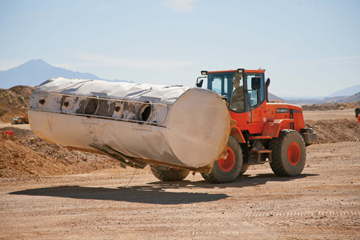Doosan Wheel Loader
The DL250TC-3 (tool carrier) wheel loader provides productivity and comfort for moving materials. Its parallel lift-arm design helps keep a pallet fork attachment and materials level at all times, which is ideal for moving materials on a jobsite or a construction yard.
 Quick look:
Quick look:
- Horsepower (net): 172 hp
- Operating weight: 31,770 lb.
- Bucket capacity: 3.4 cu. yd.
- Dump height: 9 ft.
- Breakout force: 25,980 lbf.
The 3.4-cubic-yard DL250TC-3 is a 172-net-horsepower interim Tier 4 (iT4)-compliant wheel loader, designed with a breakout force of 25,980 pounds and a dump height of 9 feet. The wheel loader’s standard auto-idle feature provides additional noise reduction and fuel savings by reducing the working idle to a standby idle setting when the machine is inactive for a short time.
The DL250TC-3 offers operators the ability to set upper and lower limits for both the lift arm and bucket stop positions from inside the cab. Better lifting capabilities improve cycle times while providing better control of the lift arm and bucket positions. An optional fourth spool control valve provides operators the capability to utilize an attachment that requires an additional hydraulic function, e.g., some snowblowers and snow blades.
As an alternative to the standard limited-slip differential, the DL250TC-3 offers an optional hydraulic locking front differential. Based on ground conditions, the operator can choose to lock the differential manually with a floor-mounted foot switch, or allow the machine to automatically engage the system. This provides increased driving power when one wheel spins or loses traction and improves machine performance when navigating tough terrain.
This Doosan wheel loader is equipped with a six-cylinder diesel engine that has been optimized for use with a cooled exhaust gas recirculation (CEGR) system, a diesel oxidation catalyst (DOC) and a diesel particulate filter (DPF). Engines with this configuration are optimized to reduce nitrogen oxides (NOX), and after-treatment is needed to reduce particulate matter to comply with iT4 emission regulations.
Click here for more information.










